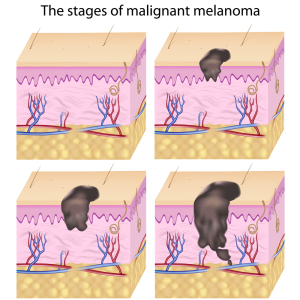As in other tumors staging of a melanoma is important in the beginning of the treatment as the treatment is different depending how advanced the melanoma is. The American Joint Committee on Cancer has come up with a generally accepted staging system. Briefly, there are 4 stages with stage I and II having each two subclasses. This way there are a total of 6 categories (Ref. 1) as is shown here.
Stages of melanoma (according to the American Joint Committee on Cancer)
Stage:
IA : localized melanoma of less than 0.75 mm thickness
IB : localized melanoma of 0.76 mm to 1.5 mm thickness
IIA : localized melanoma of 1.5 mm to 4.0 mm thickness
IIB : localized melanoma more than 4 mm thickness
III : lymph gland metastases limited to only one lymph node basin
IV : Patients with advanced regional lymph gland metastases or with distant metastases
Large numbers of patients have been followed throughout the world by various Cancer Control Agencies. Cancer survival rates with patients who were treated according to the latest generally accepted protocols for melanoma and then followed along could be accumulated as follows (Ref. 1 and 3):
_________________________________________________
10-year survival rates for all skin melanoma cases (based on stage of melanoma)
Stage I : 90% ; stage II : 60% ; stage III : 30% ; stage IV : 0%
_________________________________________________
Stage IV patients rarely lived more than 2 years. Over the years there has been a positive development in that melanoma is detected earlier. This means that more stage I melanoma is detected early today (probably because of better education of the public) and this has led to better survival rates. In this particular study more than 47% of all patients had stage I melanoma and 38% were in stage II. In other words, 85% of patients with melanomas had stage I or II melanoma. Only 13% were in stage III and only 2% were in stage IV.
The lesson to learn from this is that education regarding detecting the early stage of melanoma and instituting early melanoma treatment can change this previously vicious cancer into one with 90% to 100% survival rates over 10 years.
References:
1. Cancer: Principles &Practice of Oncology, 4th edition, by V.T. De Vita,Jr.,et. al J.B. LippincottCo.,Philadelphia, 1993.Vol.2: Chapter on Cutaneous melanoma.
2. The Merck Manual, 7th edition, by M. H. Beers et al., Whitehouse Station, N.J., 1999. Chapter 126, p. 843-845.
3. Cancer: Principles&Practice of Oncology. 5th edition, volume 2. Edited by Vincent T. DeVita, Jr. et al. Lippincott-Raven Publ., Philadelphia,PA, 1997. Chapter on Cutaneous melanoma.
4. SA Rosenberg et al. Ann Surg 1998 Sep 228(3): 307-319.
5. SA Rosenberg Nature 2001 May 17;411(6835):380-384.
6. T Todo et al. Proc Natl Acad Sci U S A 2001 May 15 ( page not available yet).
7. GJ Tsioulias et al. Ann Surg Oncol 2001 Apr;8(3):198-203.
8. Conn’s Current Therapy 2004, 56th ed., Copyright © 2004 Elsevier
9. Ferri: Ferri’s Clinical Advisor: Instant Diagnosis and Treatment, 2004 ed., Copyright © 2004 Mosby, Inc







